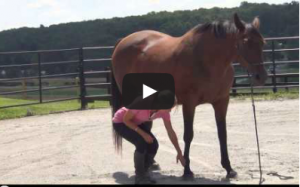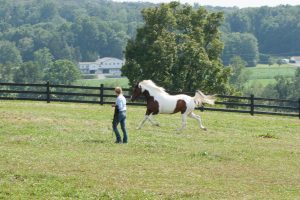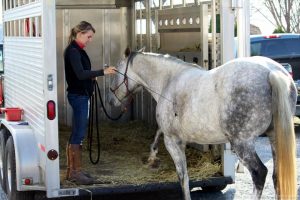We want our horses to be relaxed, calm, quiet.
However, the ideal learning state is not one of total relaxation.
The best state for training movement and balance – for us or our horses – is a state of athletic relaxation. It is a place of balance with both calmness and engagement. How do we find and recognize this state of athletic relaxation?
This summer I hosted a clinic at my farm with Patrick King, where he coached participants through the exercises of Classical In Hand work. In Hand work is a series of exercises practiced from the ground that encourage the horse to position and move their body to build strength and create suppleness.
One morning, before starting work with the horses, Patrick pulled out a paper and started drawing the yin yang symbol. From here he described what athletic relaxation means and how this is a principle we can take into all our horsemanship.
Watch the video below for Patrick’s explanation.
If you are interested in learning exercises to soften, supple, and strengthen your horse, join our course with Patrick King!
Sign Up Here: www.balanceinhand.com














16 Responses
It makes a lot of sense, my yin and yang are out so I can’t expect my horses to be.
My Horses are finding it hard to stop why playing them in a full chukker. But the are very handy why playing them stick and ball. Why?
Hi Usman, I’m not familiar with the term you used in your comment ‘chukker’. Could you explain a little more?
-Julia, CRK Training Community Manager
I would like to see and learn accurate presentation of the in-hand aids to the horse and recognition of correct responses by the horse. It can be difficult to see when the horse is over-bent or avoiding the aids for example.
Hi Val, we cover all of this in the Developing Balance In Hand program. We are actually running a free workshop from that program, you can watch the first video available now by clicking here.
-Julia, CRK Training Community Manager
Where did you get the lunging caveson? Thanks!
Hi Karla, this is Patrick King’s cavesson. To order you can reach out directly to him here: office@pkhorsemanship.com
-Julia, CRK Training Community Manager
I have a 7 year old who has thrown two people, got her saddle fixed and her back checked, all good. Her manners are terrible so I decided to take her back to ground work, she’s started to give me my space round her, she’s terrible in the stable, started jumping out over the door, she seems to get really nervous being closed in and starts jumping around it takes everything to try and stop her and get her out once out she’s fine again, then another day I put her in her stable she’s fine, I’ve tried to make it a pleasant place for her to be, by feeding her in there, brushing her etc., Somedays there just no consoling her
Hi Avril, that can be really common behavior with mares. Have you noticed any pattern to that behavior when she is around the time of her cycle?
-Julia, CRK Training Community Manager
LOVE all your videos and looking forward to the upcoming workshop with Patrick King. One of my horses, a 12 year old Arabian gelding, seems to have developed tension issues and my trainer & I are really looking forward to this workshop but worried about access to the video(s). My trainer is with horses/clients all day and is only available to watch at night. Will it be available to watch when we can? Availability of viewing?
My trainer also mentioned to me yesterday Spyder’s behaviors that appear to be related to tension and asked me to send them to you for your opinions. He does these behaviors at the start of every lesson (3/week).
~deep breathing
~lip flapping
~flicking/tossing head (as trainer, Barbara, says “like there’s a grasshopper on his nose”
these 3 behaviors are continuous 4-5 times / minute
Barbara always starts him with a steady walk until Spyder starts to settle.
When she asks for the 1st trot with a light leg on, Spyder “sucks back and gets crooked”.
Thank you for your feedback and answers to the times/availability for Patrick King’s workshop.
Roseanne Moresco
Hi Rosanne, the workshop is available to view when the timing works best for you! But the videos are only available for a short time so make sure watch them as soon as you can!
-Julia, CRK Training Community Manager
I am learning to post the trot. In my last lesson my trainer said both I and the horse were trying too hard. I feel this relates.
Hi Kate, you should also check out this video with Wendy Murdoch on how to ride the posting trot!
-Julia, CRK Training Community Manager
My Irish Sport energy is either too low or too high. I need to over-energize at the beginning of the ride so that she ‘wakes up’ and then I have to hold her back. My trainer says she knows me too much and if she can get away with working she will , until she knows I mean business. But I feel I need to be too extreme to get her connected and engaged, which is not me, and it doesn’t feel right. Otherwise she is amazing, love her to bits
the ying and yang is a sensible explanation that can apply to several aspects of riding. My most difficult transition is walk to canter or lop. If I go through walk, trot, canter or I am on a trail where my horse needs to canter up hill I transition well. but in the arena when I need to take my horse walk- canter I am not able to ease into the gait without feeling off balance or the transition being rough. Ideas how ying and yang can help with this maneuver.
hello I am new to the blog have followed youtube but I took the step to join the blog as I so appreciate the company of learning. This clip was wonderful to remind me that to not be all or none attitude and to rest in awareness in the balance of both energies thankyou in gratitude for all you share Julie